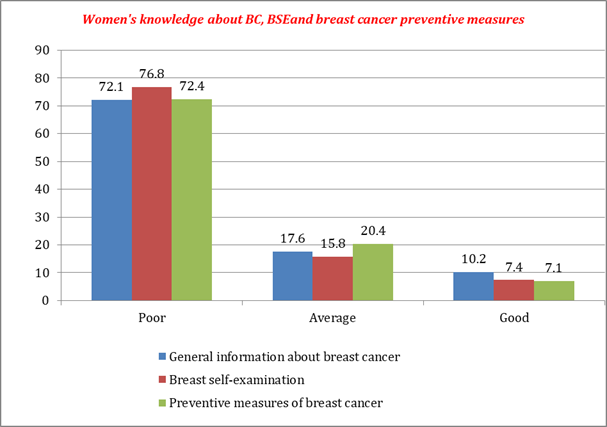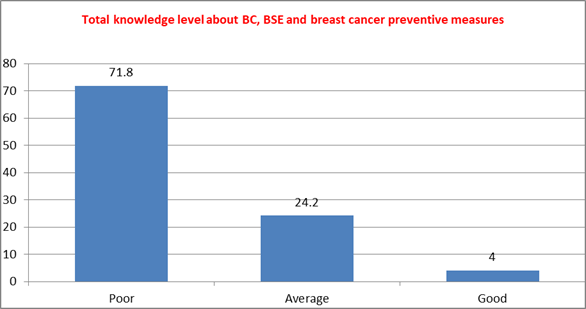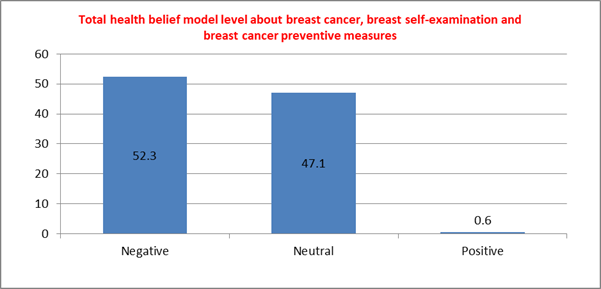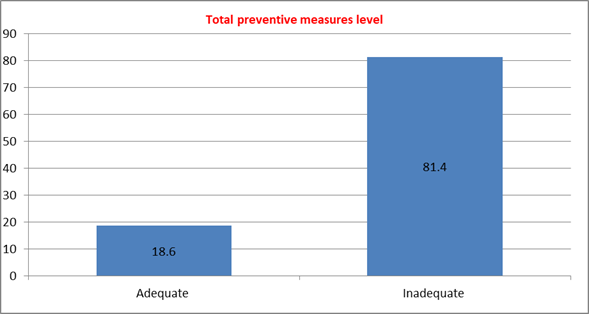eISSN: 2572-8474


Research Article Volume 11 Issue 1
1Lecturer of Maternal & Newborn Health Nursing, Faculty of Nursing, Beni-Suef University, Egypt
2Demonstrator of Maternal & Newborn Health Nursing, Faculty of Nursing, Beni-Suef University, Egypt
3Professor of Maternal and Newborn Health Nursing, Faculty of Nursing, Beni-Suef University, Egypt
Correspondence: Hanan Elzeblawy Hassan, Professor of Maternal and Newborn Health Nursing, Faculty of Nursing, Beni-Suef University, Egypt
Received: January 06, 2025 | Published: February 4, 2025
Citation: Nady FS, Zaki SG, Hassan HE. Female workers’ knowledge about breast cancer preventive measures at Beni-Suef University.Nurse Care Open Acces J. 2025;11(1):16-20. DOI: 10.15406/ncoaj.2025.11.00312
Background: Global estimates reveal striking inequities in the breast cancer burden according to human development. The best cancer therapy is prevention. Primary prevention involves health promotion and risk reduction in the general population so that invasive cancers do not develop.
Aim: assess female workers’ knowledge about breast cancer preventive measures at Beni-Suef University.
Subjects and Methods: A purposeful sample of 323 Beni-Suef University working women was chosen.
Tools:
Results: illustrated that 71.8% of studied sample had poor levels of knowledge regarding breast cancer. Moreover, 52.3% had negative beliefs based on health belief model regarding breast cancer, breast self-examination, and breast cancer preventive measures, 81.4% of the female workers have inadequate practice preventive measures. Also, 90.1% of the female workers have inadequate practice for breast self-examination. The main source of information was social media (44.9%).
Conclusion: most of the studied female workers had poor knowledge and negative attitude toward all sub-items of health belief model regarding breast cancer, breast self-examination, and breast cancer preventive measures. Moreover, most of them had inadequate practice regarding preventive measures and breast self-examination.
Recommendations: Implement an educational program to enhance women’s knowledge regarding breast cancer and its preventive measures
Keywords: workers’ knowledge, breast cancer
Breast cancer is a disease that originates from the breast and emerges mostly from the epithelial cells lining the milk ducts.1–6 Although carcinomas are cancerous by definition, benign tumors of the breast contained inside the basement membrane are described as ductal carcinoma in situ (DCIS) and lobular carcinoma in situ (LCIS).7–11 The illness known as breast cancer is caused by aberrant breast cells that proliferate and develop into tumors. Tumors have the potential to grow throughout the body and become lethal if ignored. The milk ducts and/or the breast's milk-producing lobules are where breast cancer cells first proliferate. There is no risk to life from the early form (in situ). Cancer cells can invade neighboring breast tissue. Tumors produced by this result in thickening or lumps. Metastasis is the process by which invasive tumors move to neighboring lymph nodes or other organs. One can die from metastasis.12–16 Global estimates reveal striking inequities in the breast cancer burden according to human development. For instance, in countries with a very high Human Development Index (HDI), 1 in 12 women will be diagnosed with breast cancer in their lifetime, and 1 in 71 women die of it. In contrast, in countries with a low HDI, while only 1 in 27 women are diagnosed with breast cancer in their lifetime, 1 in 48 women will die from it.17–19 The best cancer therapy is prevention. Primary prevention involves health promotion and risk reduction in the general population so that invasive cancers do not develop. These primary preventive measures include the cessation of smoking, lifestyle and diet modification, and vitamin and micronutrient supplementation. Identification of genetic risk, understanding of carcinogenesis, development of effective screening tools, avoiding risk factors, and effective chemoprevention can lead to decreased morbidity and mortality of cancers in general and, more importantly, breast cancer.20–22 The Health Belief Model was created by behavioral scientists employed by the United States Public Health Service in the 1950s, and health educators, other medical professionals, and psychologists continue to utilize it as one of the most popular conceptual frameworks for health behavior.23 The Health Belief Model is a cognitive paradigm that views people as rational beings who use a variety of techniques to decide whether or not to participate in an activity connected to their health. Created to help explain the poor participation rates in disease prevention initiatives, the Health Belief Model looked into factors that can promote or hinder participation. The two main factors that have influenced the development of the Health Belief Model are the belief that a specific behavior will either prevent or improve health and the desire to avoid illness.24–28
The current study was conducted to assess female workers’ knowledge about breast cancer preventive measures at Beni-Suef University.
Tool I: women's knowledge about breast cancer, breast self-examination, and breast cancer preventive measures. The study assessed women's knowledge about breast cancer, self-examination, and preventive measures using 55 closed-ended questions. The scores were categorized into good (≥75%), average (50-74%), and poor (<50%), with each question scoring one point for correct answers and zero for incorrect ones.
Tool II: Health belief model questionnaire: The study measures pregnant women's psychological readiness to take positive action about breast cancer prevention. It includes six subscales for health belief, with responses scored on a five-point Likert scale. The attitude score is divided into three categories: positive belief (75%), neutral belief (55%-74%), and negative belief (<50%).
Tool III: Breast cancer preventive measures checklist: It consisted of two parts:
Part 1: Talks about changing one's lifestyle to prevent breast cancer. With a total score of 13 degrees, each step was given a zero point for improper execution and a point for proper execution. Two groups were created by calculating the overall practical scores:
Part 2: Observational checklist for breast self-examination it was used as a pre- and post-educational model implementation and consisted of useful procedures to assess and monitor women's performance in breast self-examination. With a total score of 35 degrees, each step received a zero if it was not completed and a one if it was completed. Two groups were created from the total practical scores:
Figure 1 presents the percentage distribution of the studied female workers’ regarding sub-items of knowledge about breast cancer. It illustrates most of the studied female workers (72.1%, 76.8%, and 72.4%), respectively, had poor knowledge level about breast cancer, breast self-examination, and breast cancer preventive measures. Figure 2 presents the percentage distribution of the studied female workers’ total knowledge about breast cancer. It illustrates that 71.8% & 4% of studied sample had poor and good levels of knowledge, respectively. Table 1 illustrates that more two-thirds (68.1% & 66.3%) of the studied female workers have a negative attitude toward (susceptibility & cues to action) sub-items of health belief model. Moreover, more than half (62.2% & 53.3% & 51.4%) of them have a negative attitude toward (Self-efficacy & Barriers & Benefits) sub-items of HBM regarding breast cancer, breast self-examination, and breast cancer preventive measures.

Figure 1 Percentage distribution of the studied female workers regarding sub-items of knowledge about breast cancer, breast self-examination and breast cancer preventive measures (n=323).

Figure 2 Percentage distribution of the studied female workers’ regarding their total knowledge level about breast cancer (n=323).
|
Sub-items of health belief model |
Negative % |
Neutral % |
Positive % |
|
Susceptibility |
68.1 |
31 |
0.9 |
|
Seriousness |
37.2 |
55.7 |
7.1 |
|
The benefits |
51.4 |
43 |
5.6 |
|
The barriers |
53.3 |
39.3 |
7.4 |
|
Cues to action |
66.3 |
27.2 |
6.5 |
|
Self-efficacy |
62.2 |
30.3 |
7.4 |
Table 1 Percentage distribution of the studied female workers’ beliefs regarding sub-items of health belief model (n=323)
Figure 3 illustrates the female worker’s beliefs regarding breast cancer and its preventive measures based on HBM. It shows that 52.3% of them had negative beliefs while only 0.6% of them had positive beliefs regarding breast cancer, breast self-examination, and breast cancer preventive measures. Figure 4 shows distribution of the studied female workers’ total preventive measures level. It reveals that 81.4% of the female workers have inadequate practice compared to 18.6% adequate practice. Table 2 summarizes the percentage distribution of the studied female workers’ practices regarding sub-items of breast self-examination. It shows that most of the studied women (76.2%, 88.2%, 90.4%, 91.6%) have inadequate knowledge regarding all sub-items of breast self-examination (examination preparation, examination by consideration, symmetry in the nipple, areola, or breast, and tactile examination), respectively. Figure 5 illustrates the percentage distribution of the studied female workers’ total practice level regarding breast self-examination. It presents that the majority 90.1% of the female workers have inadequate practice. Figure 6 shows sources of information about breast cancer and illustrates that 44.9% of females get information about breast cancer from social media.
|
Sub-items of breast self-examination |
Adequate % |
Inadequate % |
|
Examination preparations |
23.8 |
76.2 |
|
Examination by consideration |
11.8 |
88.2 |
|
Make sure that there is asymmetry in the nipple, areola or breast |
9.6 |
90.4 |
|
Tactile examination (palpation) |
8.4 |
91.6 |
Table 2 Percentage distribution of the studied female workers’ practices regarding sub-items of breast self-examination (n=323)

Figure 3 Percentage distribution of the studied female workers’ regarding to their total health belief model level about breast cancer, breast self-examination and breast cancer preventive measures (n=323).

Figure 4 Percentage distribution of the studied female workers’ total preventive measures level (n=323).
Breast cancer (BC) is the most frequent cancer among women, and the rate of death is increasing day by day. Furthermore, because of the increase in aging, 19.3 million new cases of cancer are estimated to occur in 2025, and more than half of cancer deaths are expected to be seen in less developed regions around the world. Increased BC incidence leads to more health spending and high death rates. On the other hand, maintaining effective cancer screening is one of the most important factors to assess the outcomes of diagnosis and treatment. Due to this reason, BC should be controlled and prevented through early diagnosis and screening programs. Mammography, clinical breast examination (CBE), and breast self-examination (BSE) are crucial for early diagnosis of BC.29-33 The aim of the study was conducted to assess female workers’ knowledge about breast cancer preventive measures at Beni-Suef University. Concerning general knowledge of breast cancer, the current study revealed that most of the female workers’ had poor knowledge level about General information about breast cancer, Breast self-examination, Preventive measures of breast cancer, compared to few ones who had good knowledge. Moreover, In relation to the studied female worker’s total knowledge regarding breast cancer, breast self-examination, and preventive measures, the current study illustrated that most of the female workers’ had poor knowledge level, compared to few ones who had good knowledge. This finding was contradicted by Nema Ram, who investigated the impact of an educational program on knowledge of breast cancer and practice of breast self-examination among women in India.34
Concerning female workers’ beliefs regarding breast cancer and its preventive measures as measured by the health belief model, the current study revealed that most of the female workers’ had negative beliefs for the perceived Susceptibility, Seriousness, Benefits, Barriers, Cues to Action, and Self-Efficacy. Moreover, the minority of the studied female workers’ had positive total health belief model level about breast cancer, breast self-examination and breast cancer preventive measures. This finding parallels Khorsandi et al, who investigated “self-efficacy of the first-degree relatives of patients with breast cancer in the prevention of cancer: using the health belief model.35 Regarding the studied female workers’ total preventive measures level, the current study revealed that less than one-fifth of the female workers had adequate practice compared inadequate practice. This finding is similar to Pereira et al.36 Additionally, regarding the practice of BSE, the current study announced that the majority of the studied female workers’ had inadequate knowledge of total and all sub-items of breast self-examination (Examination preparations, Examination by consideration, Make sure that there is asymmetry in the nipple, areola or breast, and Tactile examination (palpation) compared with the adequate one. The finding was in the same line with Akarsu & Andsoy, who investigated the evaluation of breast self-examination training in Turkish women living in northwestern Turkey.29 Regarding the source of information about breast cancer, the current study illustrated that less than half of female workers get information from social media. This finding is in accordance with Mahmoud et al, who investigated the “effect of the health belief model-based education on preventive behaviors of breast cancer” and revealed that less than half of the studied women acquired their information about breast cancer from social media and the minority of them from the health care provider.37
Based on the findings of the present study, it can be concluded most of the studied female workers had poor knowledge and negative attitude toward all sub-items of health belief model regarding breast cancer, breast self-examination, and breast cancer preventive measures. Moreover, most of them had inadequate practice regarding preventive measures and breast self-examination.
None.
The authors declare that they have no conflicts of interest.

©2025 Nady, et al. This is an open access article distributed under the terms of the, which permits unrestricted use, distribution, and build upon your work non-commercially.